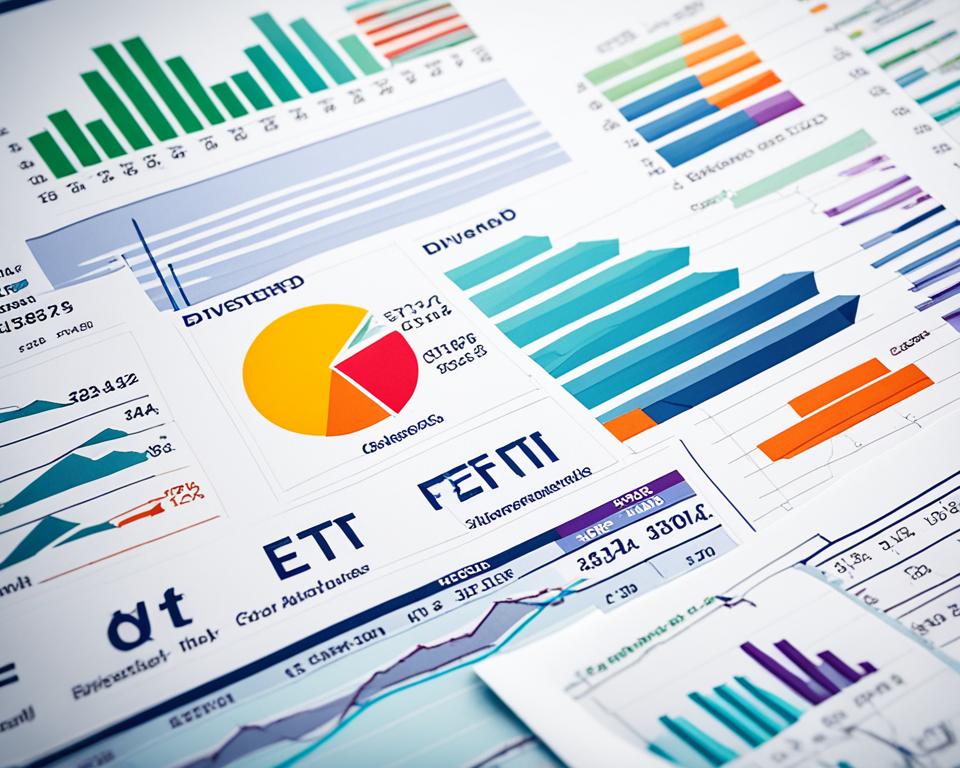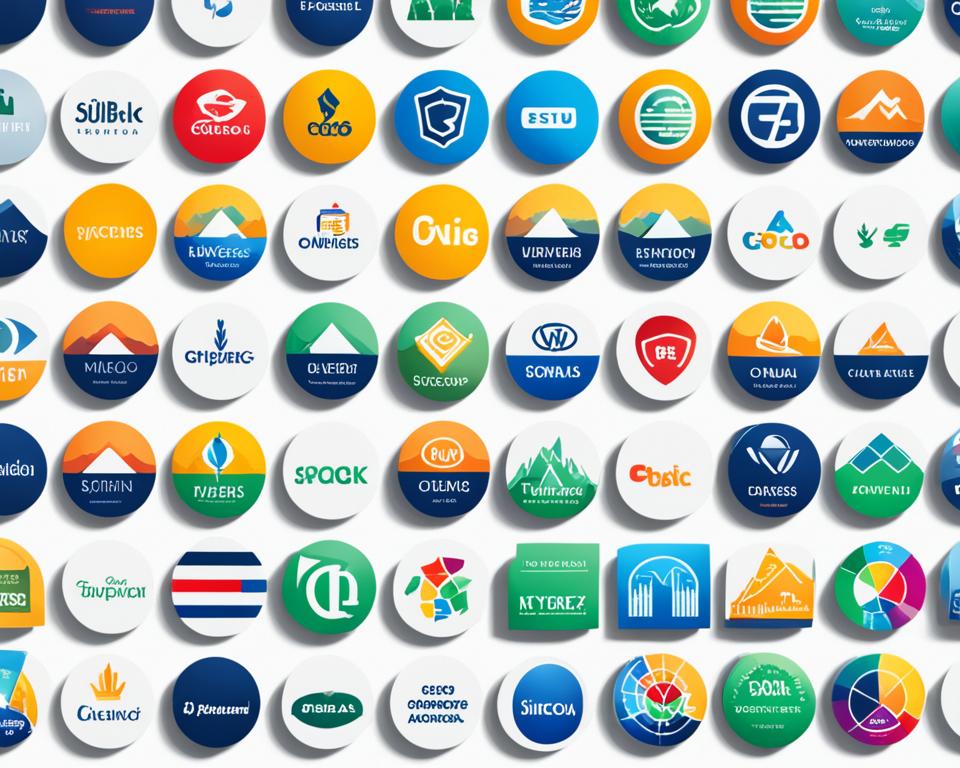For those of you keen on optimizing your investment portfolio, understanding dividend ETFs can be a game-changer. These versatile funds pool the dividends from various stocks, providing shareholders the potential for a consistent income stream. Essentially, how does a dividend ETF work? It operates as a financial vehicle, accumulating dividends from its individual holdings and dispatching that income to you, the investor, in proportion to your stake. This method simplifies diversification while affording a regular payout, often without the need to manage a myriad of individual stocks.
Whether you’re an experienced investor or just starting out, grasping the dividend ETF basics can pave the way for smarter, more strategic investment decisions. Aligning with your goals for income and growth, dividend ETFs hold the potential to play a pivotal role in your long-term wealth-building plan.
Key Takeaways
- Dividend ETFs aggregate payouts from multiple stocks, providing investors with diversified dividend income.
- Investors can receive dividend payments directly or opt for dividends to be reinvested within the ETF.
- Understanding the dividend payment schedule set by the ETF issuer is essential for strategic planning.
- Dividend ETFs can serve as a steady income source, which is a key aspect of total return on investment.
- Tax implications of dividends are a crucial consideration when incorporating ETFs into your portfolio.
- Different types of Dividend ETFs target various investment strategies to cater to specific investor needs.
- Choosing the right Dividend ETF requires assessment of the fund’s policy on dividend payouts and reinvestment.
Introduction to Dividend ETFs
Welcome to the world of dividend ETFs, a powerful investment tool designed to streamline your pathway to a steady income stream through smartly bundled equity holdings. These financial vehicles are specifically geared toward investors with an eye for stocks with robust dividend histories—those bastions of consistent payouts that form the bedrock of many a strategic portfolio.
The intriguing concept of a dividend ETF resides in its capability to round up dividends from a spectrum of selected stocks and, in turn, disburse those collective earnings to you. This fiscal arrangement speaks volumes about its allure as a passive income resource, and hinges on the strategic decisions of the ETF managers as clearly communicated in the ETF prospectus—providing transparency on whether these dividends will be paid out or reinvested to potentially augment your share value.
As you delve deeper into the dividend ETF explanation, you’ll uncover that this investment avenue captures a rich variety of sectors and strategies. From funds heavily skewed towards high-yield stocks to nuanced blends that echo broader economic patterns, the essence of a dividend ETF is in its diversity and goal alignment with your investment needs.
- Is your priority income or growth?
- Do you value the comfort of receiving regular payouts, or the thrill of reinvesting dividends for potentially higher long-run paybacks?
In the grand tapestry of dividend ETFs, these questions lead to choices, and ultimately to personalized investment experiences tailored to your financial aspirations. Now, let’s have a look at some of the key players in this sphere:
| Dividend ETF | Sector Focus | Dividend Yield | Reinvestment Policy |
|---|---|---|---|
| SPDR S&P 500 ETF (SPY) | Broad Market | Competitive | Cash Payout |
| Vanguard Dividend Appreciation ETF (VIG) | Dividend Growth | Long-term Growth | Varies by Prospectus |
| iShares Select Dividend ETF (DVY) | High Dividend | High Yield | Reinvest or Cash |
| Vanguard High Dividend Yield ETF (VYM) | Value | Substantial Yield | Reinvest or Cash |
| WisdomTree U.S. MidCap Dividend Fund (DON) | Mid-Cap | Accessible | Cash Payout |
In tuning your portfolio to the cadence of dividends, it becomes imperative that you align with an ETF that mirrors your financial symphony—one whose dividend ETF concept and policy harmonize with your approach to investing.
Whether you’re taking assured baby steps into the realm of income-focused investing or expertly crafting a dynamic and yielding asset mix, dividend ETFs emerge as versatile financial instruments ripe for exploration.
How Does Dividend ETF Work
Embarking on the journey of dividend ETF investing means embracing an investment that operates distinctively in comparison to individual stock dividends. At its core, the dividend ETF process represents a method of accumulating and distributing earnings that is both streamlined and investor-friendly. If you’re exploring financial instruments that generate potential income through dividends, understanding the mechanics of a dividend ETF is essential.
The Basics of Dividend Distribution
Dividend ETFs feature a straightforward yet powerful system of dividend distribution. They collect dividends paid by the array of companies within the ETF’s portfolio, and then, much like a fund manager apportioning profits, they distribute these dividends to ETF shareholders on a pro-rata basis. This essential aspect of the dividend ETF basics allows you to receive a share of the profits from a diverse collection of stocks, proportional to your investment, but without the fuss of handling numerous individual transactions.
ETFs vs. Individual Stocks: Dividend Collection
An individual stock pays dividends directly to its shareholders following its own payment schedule. In contrast, a dividend ETF compiles the dividends from all of its constituent stocks and pays them out on a schedule determined by the ETF sponsor. That’s the dividend ETF structure at play—the schedule may not align with the individual dividend payouts of the stocks contained within the ETF, but it aims for consistency and predictability for you as an investor.
Dividend ETFs: A Structure Overview
The ETF structure isn’t overly complex, but it is ingenious. Inside a dividend ETF, you’ll find a collection of dividend-paying stocks whose earnings are neatly pooled. The management of these funds can either distribute accumulated dividends to the shareholders in the form of cash, or alternatively, reinvest them back into the ETF, thus harnessing the power of compounding. The dividend ETF mechanics, governed by ex-dividend, record, and payment dates, are laid out in the fund’s prospectus for transparency.
Understanding the nuances of dividend ETFs elevates your knowledge and empowers you to make informed decisions, adding a layer of financial acumen to your investment strategies. Ready to see what an ideal dividend ETF portfolio might look like?
As you familiarize yourself with these concepts, remember that the ease of managing your dividends through ETFs can potentially smooth the path to achieving your financial objectives. Reflect on your own goals, and consider how the integration of dividend ETFs could fortify your investment approach.
The Role of Dividends in ETF Investments
As you venture deeper into the realm of investment strategies, understanding dividend ETFs becomes crucial. Dividends are not just occasional perks; they are a fundamental component of an investor’s total return. When you invest in an ETF, the dividends it accumulates from its holdings significantly bolster your potential income. This is why a thorough grasp of the dividend ETF concept is pivotal—it allows you to harness the full power of these distributions.
Historical data underscores the impact of dividends, revealing that they have accounted for a sizable portion of stock market returns over time. This enduring strength makes dividends essential for those seeking income through their investments. When considering dividend ETFs for your portfolio, it’s important to focus on the payment histories and policies of the funds, ensuring they align with your income goals.
Why are dividends important in an ETF context? It’s simple: they represent a share of a company’s profits paid out to its shareholders, effectively giving you a slice of the company’s success. But there’s more—when bundled within an ETF, these dividends offer you diversification that would be challenging to achieve on your own. Think of it as streamlining the dividends from a broad market segment into a single, manageable investment.
Digging into the prospectuses of various dividend ETFs, you’ll notice statements about their commitment to providing shareholders with consistent dividends, reflective of the funds’ strategies and the dividend-paying companies they contain. Each prospectus serves as a resourceful guide to understanding how a particular ETF will factor into your income objectives.
- Dividend ETFs afford investors the benefit of regular income, contributing to the stability and predictability of returns.
- The selection of a dividend ETF should be informed by the fund’s past dividend payment history—indices it tracks, frequencies of payouts, and the general health of dividends distributed.
Now, consider the dividend reinvestment options at your disposal. Many ETFs give you the choice to have these dividends paid out in cash, or to reinvest them, compounding your earnings and potentially elevating your investment growth over time. This choice is a testament to the flexibility and investor-friendly nature of dividend ETFs.
So, whether you are in pursuit of an income stream to complement your retirement plan or to further diversify your investment horizons, dividend ETFs warrant attention. Their role in shaping a fruitful and resilient portfolio cannot be overstated, but of course, as with all investments, due diligence is your faithful companion on the road to financial wisdom.
Analyzing Dividend ETF Distributions
Investors considering dividend-focused exchange-traded funds (ETFs) are often drawn to the dividend ETF explanation for its promise of regular, distributed income. Here, we take a closer look at the dividend payout process specific to ETFs, dissecting the mechanics and timings that underpin these transactions.
Understanding the Dividend Payout Process
The dividend ETF mechanics involve the aggregation of dividends received from the stocks within the fund’s portfolio. Instead of each stock distributing dividends individually to ETF shareholders, the ETF issuer collects these payments and disburses them on predetermined dates. This process is delineated in the fund’s prospectus, which also states the policy on whether dividends are paid out in cash or reinvested in the fund. These disbursements are typically scheduled for the end of the ETF’s fiscal quarter, providing a predictable income stream for investors.
While the concept might seem straightforward, the execution is nuanced and dynamic, characterized by the perpetual motion of collection and distribution, mirroring the ebb and flow of market tides. This orchestration seeks to maximize efficiency and maintain the fund’s attractiveness as a steady source of income.
Key Dates for Dividend ETF Investors
For investors aiming to capitalize on ETF dividends, understanding key dates is as crucial as mastering the notes to a complex symphony. These dates include the ex-dividend, record, and payment days. Here’s a breakdown:
| Key Date | Description | Investor Action Required |
|---|---|---|
| Ex-Dividend Date | The cutoff day when a stock trades without its upcoming dividend value. | Own ETF shares before this date to be eligible for the dividend. |
| Record Date | The issuer’s designated date to list shareholders eligible for the dividend. | Ensure your shares are settled in your account before this date. |
| Payment Date | The actual day on which the dividends are paid out to shareholders. | None; Dividends are either distributed or reinvested based on the fund’s policy. |
These dates function as the timeline that ETF investors must consider when planning their investments around dividend payments. They are etched in every ETF’s prospectus, making them publicly available, and function as a guide to the timing and reception of dividends – key pieces of the greater dividend ETF explanation puzzle.
Now that you have a deeper understanding of the dividend ETF mechanics and critical dates, you’re well-equipped to make informed decisions about integrating these funds into your investment portfolio.
Exploring the Types of Dividend ETFs
As you delve into the realm of dividend-yielding investments, you’ll find that how dividend ETF works hinges on its structure and the ingredients it encompasses. The variety of dividend ETFs available can cater to a range of investment strategies and appetites for risk. Let’s explore the broad spectrum of these investment vehicles to enhance your understanding of dividend ETF basics.
Dividend ETFs often mirror the performance of a specific index known for its dividend yield. For example, some ETFs track indices that list companies with a history of consistent dividend growth, while others aim for high-yield dividends irrespective of growth.
Beyond these, there are dividend ETFs that concentrate on preferred stocks—which typically offer higher dividend yields—or those that span international markets, tapping into the dividend potential of overseas companies. Understanding the nuances of these different types may inform where you decide to invest, based on your income goals and risk tolerance.
| Type of Dividend ETF | Index Tracked | Focus |
|---|---|---|
| Dividend Growth ETFs | S&P U.S. Dividend Growers Index | Companies with a record of increasing dividends |
| High-Yield Dividend ETFs | S&P High-Yield Dividend Aristocrats Index | Companies with high current dividend yields |
| International Dividend ETFs | Various global indices | Non-US companies with attractive dividends |
| Preferred Stock ETFs | Custom preferred stock indices | High-yielding preferred stocks |
The table above provides a glance at some of the dividend ETF types, each with its investment horizon and target sector. Whether your investment strategy favors growth or immediate returns, you can find a dividend ETF tailored to your financial pursuits.
Drawing on these options, you can build a portfolio that reflects your preference: seeking the steadiness of companies with long dividend histories or venturing into the realms of preferred stocks for potentially higher yields. As you chart your course through the world of dividend ETFs, consider how each fund works in concert with your income goals and the level of market engagement you wish to maintain.
Remember, dividend ETF basics aren’t just about picking funds with high yields but also understanding the strategies behind them. Some funds may aim for stability and consistency, while others might pursue aggressive growth. Your pathway to a fitting dividend ETF begins with a clear grasp of these foundational principles and navigates through the varied options available to you.
The Tax Implications of Dividend ETFs
When adding dividend ETFs to your portfolio, it’s key to understand the financial repercussions, including the tax requirements. The dividend etf taxes can affect the overall return on your investment, thus, factoring in the tax implications is a part of the savvy investor’s strategy.
How Dividends from ETFs Are Taxed
Just like dividends from individual stocks, the income you earn from dividend ETFs falls under the purview of taxation. It’s important you know that these dividends are taxed in the year they are distributed, regardless of whether you opt for reinvestment or cash payouts. This element of the dividend etf process means that dividends contribute to your taxable income, potentially impacting your tax bracket and the amount you owe.
Considerations for Tax-Efficient Investing
Beyond just understanding the tax treatment of dividends, constructing a tax-efficient investment strategy can benefit your long-term financial health. By grasping the structure of dividend ETFs and the timing of their distributions, you can make choices that may reduce your tax burden. For instance, ETFs domiciled in certain jurisdictions may offer more favorable tax treatments on dividends, while others may allow some control over the timing of capital gains taxes.
As you navigate the often-complex waters of investment taxes, remember that information is power. Stay informed on current tax laws, and consider consulting with a tax professional when necessary to ensure that you are making the most tax-efficient decisions for your dividend ETF investments.
Dividend Reinvestment Strategies in ETFs
As an investor focusing on the dividend ETF process, you’re likely to encounter a strategic choice: whether to reinvest dividends or receive them as cash. Each option has its mechanics and potentially different outcomes for your investments. Let’s take a closer look at the paths you can take within the framework of dividend ETF mechanics.
Direct Reinvestment vs. Cash Distributions
When it comes to managing dividend payouts, the ETF landscape provides flexibility. Opting for direct reinvestment means your dividends are automatically used to purchase more shares of the ETF without incurring trade fees—a seamless addition to your investment. Conversely, choosing cash distributions provides immediate liquidity, with the dividend paid out in cash, which you can utilize for any expense or reinvestment.
The right choice hinges on your investment goals and current financial needs. If long-term growth is your aim, you might find direct reinvestment appealing. If short-term financial needs or opportunities are your focus, then cash distributions might make more sense.
The Compounding Effect of Reinvested Dividends
As with many investment decisions, compound interest plays a compelling role in the dividend ETF process. Reinvesting dividends back into the ETF can ignite the power of compounding, effectively amplifying your investment’s value over time. However, it’s essential to recognize that this approach could introduce some leverage within the ETF, which may elevate its performance in a bull market and conversely, affect it when the market dips.
Understanding this dynamic can help you craft a strategy aligned with your tolerance for risk and investment horizon. This approach encapsulates a proactive take on the dividend ETF mechanics, where each reinvestment incrementally expands your share in the ETF’s performance.
Consider this scenario illustrated in the table below:
| Investment Approach | Immediate Benefits | Long-Term Effects | Risk Considerations |
|---|---|---|---|
| Direct Reinvestment | Additional ETF shares | Compounded growth potential | Exposure to leverage-related risks |
| Cash Distributions | Liquidity for other uses | No direct compounding in ETF | Limited market exposure risks |
As you map out your dividend strategy in the context of ETFs, remember that the choice extends beyond the present. It’s a decision that shapes the trajectory of your investment journey.
Whether you aim to reinvest dividends directly or to take them as cash, this key aspect of the dividend ETF mechanics is central to growing your financial portfolio in a way that matches your personal investment philosophy.
Evaluating Dividend Payouts Within Various ETFs
When delving into the world of exchange-traded funds, it’s imperative to grasp how dividends work in an ETF. This understanding is particularly crucial when considering high-dividend ETFs, known for their emphasis on stocks with solid dividend payment histories. A savvy investor looks beyond surface yields, delving into the intricacies of fund composition and distribution strategies for a thorough dividend ETF explanation.
High-Dividend ETFs: What You Need to Know
At the forefront of high-dividend ETFs are criteria such as sustainability and consistency. These funds appeal to investors who prioritize regular income from their holdings. Yet, it is important to recognize that a history of high dividends doesn’t guarantee future performance. Therefore, examining sector focus and how a fund positions itself within market volatilities becomes a crucial part of the due diligence process.
Performance Analysis: Yield vs. Total Return
Yield is often the star of the show when it comes to income investing, but it shouldn’t be the only factor in play. A comprehensive performance analysis of an ETF includes both its yield and its total return. The latter encompasses capital gains and could signal the long-term viability of the fund. After all, while high yields are attractive for immediate income, it’s the total return that could dictate the enduring profitability of your investment.
| ETF | Yield | Total Return | Sector Concentration | Dividend Sustainability |
|---|---|---|---|---|
| High-Dividend ETF A | High | Varies | Energy | Stable |
| High-Dividend ETF B | Moderate | Consistent Growth | Healthcare | Increasing |
| Total Market ETF C | Low | Strong | Diversified | Fluctuating |
This table highlights the importance of diversification within a high-dividend strategy, showing that a sole focus on yield might ignore potential risks associated with sector concentration. Additionally, evaluating the sustainability of the dividends informs your strategy, as those dividends ultimately contribute to the total return and the real growth of your investment.
Understanding the Risks of Dividend ETFs
As you navigate the investment landscape, it’s crucial to equip yourself with a comprehensive dividend ETF explanation. While these funds can be cornerstones of a diversified portfolio, they are not free from risk. Understanding the potential dividend ETF risks ensures that your investments align with both your financial objectives and your capacity for risk.
Market Volatility: Dividend ETFs are subject to market fluctuations that can affect the underlying stock prices within the fund. This can impact the overall value of the ETF and subsequently, your investment. Market trends and economic cycles can cause variabilities in the performance of dividend ETFs, sometimes resulting in dividend cuts or suspensions by the underlying companies.
Changes in Dividend Policies: Understanding that companies within the ETF have the autonomy to alter their dividend policies according to their fiscal health is vital. A change could mean a decrease in expected income from your dividend ETF holdings, highlighting the importance of staying informed about the companies within the ETF.
Interest Rate Sensitivity: Another layer of risk within dividend ETF investments is their sensitivity to interest rate changes. As rates rise, the allure of higher yields from fixed-income investments can negatively impact dividend stock valuations, requiring you to consider broader economic trends in your investment approach.
Industry-Specific Risks: Certain sectors represented within the dividend ETF might be susceptible to industry-specific setbacks. It’s crucial to analyze the sectors your ETF is invested in and understand these implications. As such, staying agile and informed about the sectors in your portfolio becomes an ongoing responsibility for any prudent investor.
Assessing the dividend ETF risks means taking a critical look at the components of your preferred ETFs, the sectors they touch upon, and their individual company health, especially as it pertains to their ability to maintain dividend payouts.
| Risk Category | Impact on Dividend ETF | Factors to Consider |
|---|---|---|
| Market Volatility | Impact on Overall ETF Value | Economic trends, Market cycles |
| Dividend Policy Changes | Changes in Expected Income | Company Fiscal Health |
| Interest Rate Sensitivity | Attractiveness Compared to Fixed Income | Central Bank Policies, Inflation |
| Industry-Specific Setbacks | Sector-focused ETF Vulnerabilities | Technological Changes, Regulatory Shifts |
Integrating dividend ETFs into your portfolio calls for a dynamic and nuanced approach, with an eye towards risk evaluation. Remain mindful of economic indicators, corporate news, and regulatory changes, and consider these in the context of your investment horizon and risk appetite. A well-informed strategy will be your ally against the intrinsic unpredictability of the markets.
How to Select the Right Dividend ETF for Your Portfolio
Embarking on the journey of optimizing your portfolio begins with the crucial step of understanding dividend ETFs. It demands clarity about your financial aspirations and how much risk you’re willing to take on. In this pursuit, it’s not only about grasping the dividend etf basics but delving deeper into your personal investment goals and matching them with the right dividend ETF.
Identifying Goals and Risk Tolerance
Your investment objectives act as a beacon, guiding you through the diverse landscape of dividend ETFs. Are you looking for consistent income, or are you eyeing growth potential? Perhaps you’re balancing both. Moreover, your risk tolerance—your financial and emotional readiness to handle the ups and downs of the market—will significantly influence your choice of ETF.
Determining your comfort level with market fluctuations, and where you stand on the spectrum from conservative to aggressive investor, is essential in the dividend etf process. This self-reflection is a foundational step in selecting an ETF that resonates with your financial blueprint.
Key Metrics for Assessing Dividend ETFs
After pinpointing your targets and risk appetite, it’s time to dissect the core characteristics of dividend ETFs to pinpoint your ideal match. You’ll want to look at:
- Fund’s yield: A direct reflection of the income you might expect relative to your investment.
- Dividend growth rate: Indicates the potential for income to increase over time.
- Payout ratio: Helps assess the sustainability of dividend payments.
- Expense ratio: Lesser-known but equally vital to understanding net returns.
Beyond these metrics, consider the ETF’s history of performance and how it fits within your broader investment strategy. Ensure that the ETF’s sector allocations do not overlap excessively with other parts of your portfolio to maintain diversification.
| ETF Metric | Why It Matters | Notes for Investors |
|---|---|---|
| Fund Yield | Indicator of current income potential | Higher yields can be attractive, but they’re not the only factor. |
| Dividend Growth Rate | Signals increasing payout potential | A sign of corporate health and a hedge against inflation. |
| Payout Ratio | Measures dividend sustainability | Too high might signal an unsustainable dividend. |
| Expense Ratio | Affects the net return on your investment | Lower expense ratios mean fewer costs eating into your dividends. |
Armed with this knowledge and a robust evaluation strategy, you’re now better equipped to navigate the waters of dividend etfs. Remember, selecting the optimum ETF requires an attuned balance between understanding the fund’s characteristics and aligning them with your investment ethos.
Conclusion
Wrapping up our exploration, the dividend ETF concept is revealed as a layered yet accessible strategy that merges the allure of regular dividends with the prudence of diversification. By understanding dividend ETFs, you’ve acquired knowledge about how these funds operate, the significance of their payout schedules, and the vital tax considerations they entail.
Your journey through the intricacies of dividend ETFs has equipped you with the discernment to evaluate different funds and the insight to appreciate their place within a sound financial strategy. The fusion of income and diversification these ETFs offer makes them a compelling choice for many investors aiming for steady returns.
Remember, as you weigh your options and select the right dividend ETF, align that choice with your unique financial goals and risk appetite. The dividends of today, when chosen wisely, can sow the seeds for a flourishing financial future. Here’s to making informed choices that resonate with your investment aspirations!
FAQ
What Is a Dividend ETF and How Does It Work?
A Dividend ETF is an investment fund that trades on stock exchanges, much like stocks, and focuses on dividend-paying companies. It works by pooling dividends paid by the underlying companies it holds and then distributing these collected dividends to ETF shareholders based on the number of shares they own.
How Are Dividends Distributed in Dividend ETFs?
Dividends in ETFs are distributed to the fund shareholders after the ETF has collected dividend payments from the underlying stock holdings. These are then paid out to investors on specific dates as per the ETF’s policy, often quarterly. Investors can choose to receive these dividends as cash or have them reinvested.
What Are the Key Differences in Dividend Collection Between ETFs and Individual Stocks?
Unlike individual stocks that pay dividends directly to the stockholders on record, ETFs pay out dividends on a set schedule determined by the ETF sponsor. This can streamline the process for investors who rather than tracking multiple individual dividend payments, receive a consolidated dividend from the ETF.
What Are the Benefits of Dividend ETFs?
Dividend ETFs offer diversification across numerous dividend-paying stocks from different sectors or geographical locations. They provide a regular income stream and the potential for your investment to grow, making them appealing for income-driven investors or those seeking to reinvest to compound returns.
How Are Key Dates Like Ex-Dividend and Payment Dates Determined for Dividend ETFs?
Key dates such as ex-dividend, record, and payment dates are set by the ETF issuer and are publicized to investors, often through the fund’s prospectus. These dates are important to determine when you must own shares to be eligible for dividends and when you will receive the dividend payments.
What Are the Tax Implications of Owning a Dividend ETF?
Dividends received from a Dividend ETF are typically taxable in the year they are distributed, just like with individual stocks. This tax is applicable whether dividends are received as cash or reinvested in additional ETF shares. It’s important to consider the tax consequences as part of your investment strategy.
Can I Automatically Reinvest the Dividends I Receive From a Dividend ETF?
Yes, many Dividend ETFs offer dividend reinvestment plans (DRIPs) which allow you to automatically reinvest your dividends in additional shares of the ETF, often with no additional commission. This can be beneficial for compounding growth over time.
How Do I Analyze a Dividend ETF’s Performance?
To analyze a Dividend ETF’s performance, you should review its yield, total return, and the consistency of its dividend payouts. It’s also essential to consider the past performance of the ETF, the stability of the dividends paid by companies within the fund, and how it aligns with your investment goals.
What Are the Risks Associated With Investing in Dividend ETFs?
Dividend ETFs carry market risks like any other investment. These include stock market fluctuations, changes in the dividend policies of the underlying holdings, and potential concentration in certain industries that can impact fund performance during different economic cycles. It’s crucial to understand these risks before investing.
How Do I Choose the Right Dividend ETF for My Portfolio?
When choosing a Dividend ETF, evaluate your financial goals, risk tolerance, and investment timeline. Look at the ETF’s focus on particular sectors, its yield, dividend growth, expense ratio, and how it complements your overall investment strategy. Aligning these factors with your goals will guide your selection.
What Types of Dividend ETFs Are Available?
Dividend ETFs come in various forms and can be focused on high yield, dividend growth, or a mix of both. Some ETFs track specific indices like the S&P High-Yield Dividend Aristocrats Index or operate international strategies, offering investment exposure to global dividend-paying stocks.
How Frequently Do Dividend ETFs Pay Out?
Most Dividend ETFs pay out dividends on a quarterly basis, though some may distribute them monthly or annually. The frequency of payout can depend on the underlying stocks’ own dividend schedules and the policies of the ETF provider.












